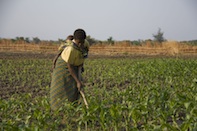New York, June 28th 2011– Original article published by IPS News, can be found here.
By Kristin Palitza
CAPE TOWN, Jun 27, 2011 (IPS) – Of the millions of dollars spent on climate change projects in developing countries, little has been allocated in a way that will benefit women. Yet, in Africa, it is women who will be most affected by climate change.
According to United Nations data, about 80 percent of the continent’s smallholder farmers are women. While they are responsible for the food security of millions of people, agriculture is one of the sectors hardest hit by climate change.
“There is a lot of international talk about climate change funding for local communities and especially for women, but not much is actually happening,” says Ange Bukasa, who runs investment facilitation organisation Chezange Connect in the Democratic Republic of Congo (DRC).
Bukasa was one of the delegates at the Climate Investment Funds (CIF) 2011 Partnership Forum, which was held from Jun. 24-25 in Cape Town, South Africa.
The Climate Investment Funds (CIF), established by the World Bank in cooperation with regional multilateral development banks, provide funding for developing countries’ climate change mitigation and adaptation efforts.
Since their launch in 2008, the CIF have allocated 6,5 billion dollars to climate change projects in 45 developing countries. More than a third of the money went to 15 African states.
But most of the money – more than 70 percent – is financing large-scale clean technology energy and transportation projects. These are traditionally male-dominated sectors of the formal economy.
Only 30 percent is being spent on small-scale projects that directly benefit poor, rural communities and thereby potentially improve women’s livelihoods.
Experts at the United Nations Development Programme (UNDP) warn that the funds could run the risk of perpetuating existing gender imbalances.
To take into account the gendered nature of energy consumption and domestic labour patterns in a resource-poor context, women need to be consulted when designing and implementing climate change mitigation and adaptation initiatives, they say.
But that doesn’t happen often enough. “The links between large regional institutions that administer the funds and the people on the ground who need to access them are missing,” says Bukasa, who works with farmers in Katanga in the southern DRC and elsewhere in the country.
She complains about a lack of consultation of women, who make up the majority of smallholder farmers in the area. Bukasa also points out that most rural communities have not been sufficiently educated about what climate change is and how to mitigate it or adapt to it.
“People may have heard the words ‘climate change’, but they have no clue what to do about it and where to access information,” Bukasa warns.
That means that they remain unable to identify problems and solutions related to climate change and hence cannot develop their own projects and apply for funds. Their only option is to “continue farming like before”, she sighs.
Such feedback from climate change experts working at community-level seems to have had some effect, however. The banks managing the CIF have now pledged they will integrate gender indicators into all operations and include them in the main criteria for the approval of grants.
Gender analysis, sex-differentiated data, gender monitoring and gender auditing will also be part of all projects financed by the CIF to ensure they benefit men and women equally, they promise.
“We are planning to take gender into greater account and are introducing more and more indicators to assess the gender dimension of projects,” says Mafalda Duarte, climate finance coordinator at the African Development Bank (AfDB), one of the regional institutions administering the funds.
Duarte says there is a particular focus on financing off-the-grid energy technologies that will improve the lives of women and girls, because they are still lumped with the burden of fetching wood and water in rural communities.
The funds will go towards solar energy projects, improved cooking stoves, sustainable forestry projects, solar-powered irrigation as well as water storage and heating systems. “When we review proposals we ensure that women will be able to access the funded technologies,” Duarte adds.
The only drawback is that the focus is again on small-scale investments that only make up a small percentage of the overall funds. Duarte admits that more needs to be done: “We do need to increase the scale of gender-sensitive projects because we have too many poor hotspots on the continent.”
Florah Mmereki, project manager at Wena Industry and Environment, an environmental education trust based in Gaborone, Botswana, agrees that efforts need to be accelerated: “The few climate change project projects that exist in Botswana today are not targeted at women. It’s a huge oversight.”
Mmereki says women remain excluded because participation in many climate change adaptation projects usually requires an upfront investment, such as a contribution to the cost of energy-efficient wood stoves.
“But rural women don’t have access to funds. They are the ones working in the fields, but it’s their husbands who manage the money,” she notes. “There are many gender barriers that still need to be removed.” (END)



